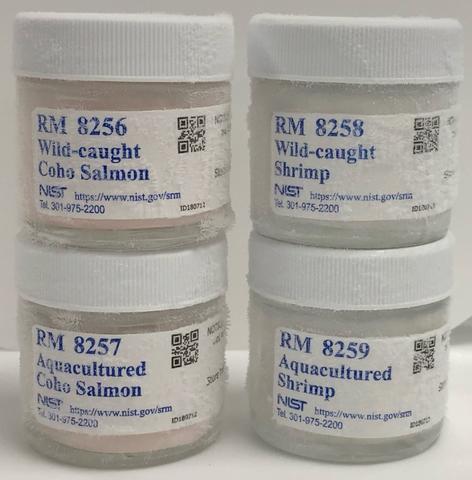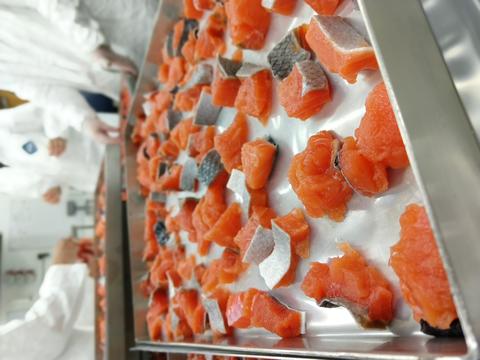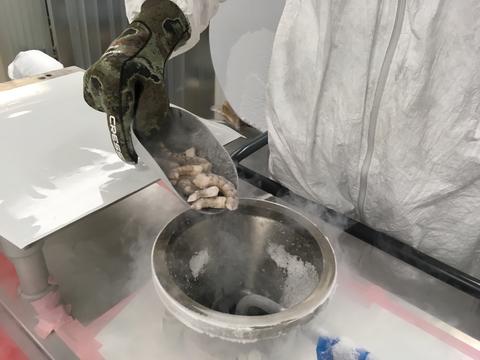Four NIST Reference Materials Help Authenticate Shrimp and Salmon
Wild-caught Coho Salmon (RM 8256), Aquacultured Coho Salmon (RM 8257), Wild-caught Shrimp (RM 8258), Aquacultured Shrimp (RM 8259)

Reference materials with extensive analysis of the fatty acids and proteins in wild-caught and farmed shrimp and salmon provide quality assurance for the tests used to validate claims of the source of these popular seafoods.
Four reference materials from NIST will help the U.S. Food and Drug Administration and Customs and Border Protection agencies assess whether imported salmon and shrimp are authentic. Food fraud, the intentional misrepresentation of a less expensive material for a more expensive one, is estimated to affect about 1% of the food industry worldwide and cost as much as $40 billion a year.*
Salmon and shrimp are two of the three most-consumed seafoods in the U.S. (tuna is the third), and seafood is one of the most highly traded international commodities. Farmed, or aquacultured, salmon and shrimp are less expensive to produce, compared to salmon and shrimp netted in the wild from boats. Aquaculture facilities are either on shore or close to shore, so the catches require less fuel and lower labor costs. A producer who substitutes farmed seafood for wild-caught seafood can earn higher profits, if fraudulently. NIST developed two reference materials for each to help regulators and law enforcement agencies differentiate between farmed and wild-caught salmon and shrimp.
Genetic analysis can be used to determine the origin of shrimp, as wild-caught shrimp represent a different species than aquacultured shrimp. A definitive identification of salmon, however, requires an analysis of the ratios of Omega 3 to Omega 6 fatty acids in their flesh, which vary likely because of the different diets eaten by aquacultured and wild salmon. Aquacultured salmon has twice the amount of Omega 3 fatty acids, according to the NIST analysis. This can be used as a tell-tale marker for federal and other agencies testing the authenticity of salmon.
NIST provides values for fatty acids for all four reference materials so that they can also be used to assure the quality of measurements of nutrition. Values for crude protein are also provided for labs that wish to use these materials to assure the quality of tests to detect allergens.
NIST carefully sourced the shrimp and salmon for all four reference materials to be confident that they are as claimed. The National Oceanic and Atmospheric Administration Northwest Fisheries Science Center Forensic Laboratory provided expertise in identifying verified fisheries and facilities capable of providing authentic seafood products. Genetic analysis was conducted on all four materials to assist in verifying their source. In addition, because the final reference materials are intended to represent food items, only those portions of the shrimp and salmon typically consumed were included in the production of these reference materials.
A unit of each of these reference materials includes two glass jars, each containing approximately 6 g to 8 g (wet basis) of frozen tissue homogenate that has been stored at −80 °C or lower since preparation.
Learn more:
Ellisor DL, Place B, Phillips M, Yen J (2021) Analysis of Seafood Reference Materials: RM 8256, RM 8257, RM 8258, and RM 8259, Wild-Caught Coho Salmon (RM 8256), Aquacultured Coho Salmon (RM 8257), Wild-Caught Shrimp (RM 8258), Aquacultured Shrimp (RM 8259). (National Institute of Standards and Technology, Gaithersburg, MD), NIST Special Publication (SP) 260-214. https://doi.org/10.6028/NIST.SP.260-214.



